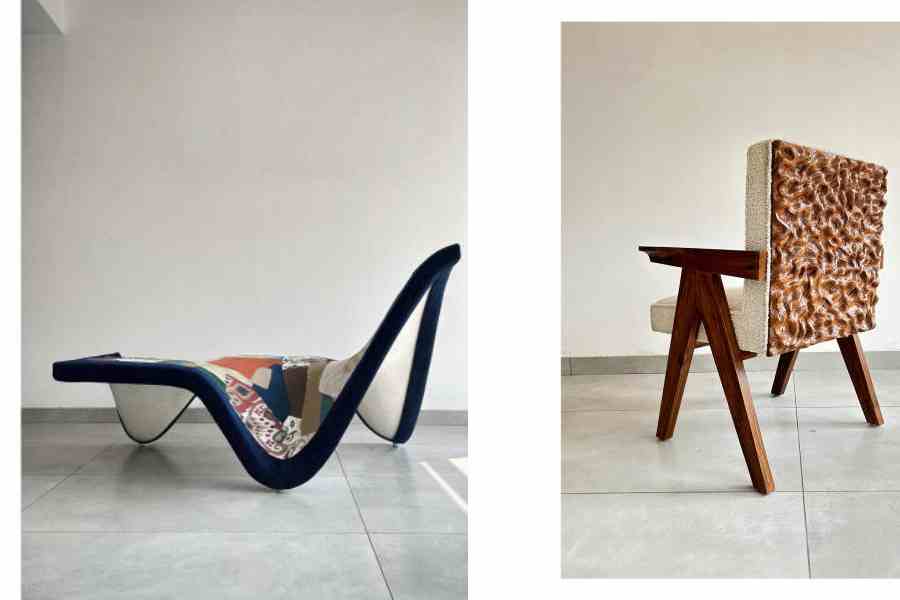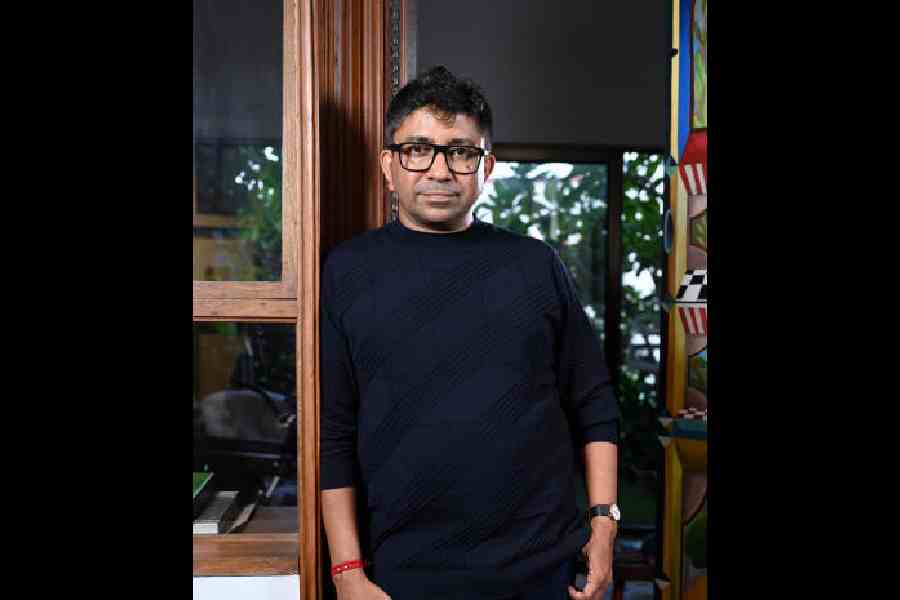Focused on holistic design, the work of city-based architectural and design firm Abin Design Studio pushes the boundaries of conventional architectural concepts and spatial constructs, encompassing in its creations a physical manifestation of multi-disciplinary ideas and paradigms. A recipient of many national and international accolades, the design house was one of the select participants at the prestigious Maison et Objet design exhibition in Paris, held during January 18-22, where it launched its latest furniture collection titled Hands&Minds. A t2oS chat with Abin Chaudhuri, founder of Abin Design Studio.
Is this your first time participating at the show? What does the show mean to you?
Yes, it is the first time. This show is one of the most prestigious and prominent exhibitions in the world as far as design is concerned. It is held twice annually, in September and January. The one in January is the more important one as it brings together the best in terms of talent and innovation in object design from across the globe. So we are very proud to be participating in it. This is also the 30th year of the exhibition. So yes, we are very excited to be among the designers taking part in this show and excited to be able to showcase the collection Hands & Minds that we have specially designed for it.
Tell us how it all happened… how did you get selected for Maison et Objet?

We had been discussing the possibility of our participation with the organisers for the last eight or nine months. We had to send pictures of our products, our processes, of the making, typology, and so on to them that we had developed for over a year. Then they evaluated in terms of category, style and the genre in which our work can be showcased. After the selection process, they finally sent us a confirmation and then the official process of participating along with logistics planning started.
Are there any minimum or essential quality and design standards or protocols that one must adhere to or surpass before one can aspire to participate in a prestigious exhibition like this?
Yes. Mainly, the product being showcased has to be unique; in other words, it has to be developed from an original idea. We have already gained copyright for five of the furniture pieces we shall be showcasing. So the best of the best craftspeople and designers come with their unique design ideas, which they have given expression to through their projects. It could be an art object, a ceramic product or a fabric, or furniture. It is really quite challenging because unless the pieces are genuinely unique with a global appeal, they do not get selected. Other than that they also evaluate on parameters like technique and finishing. When you meet all these standards, only then are you allowed to register for the event.
Do share with us something about your journey... how did you become the designer that you are today?
I am a trained architect and industrial designer. I began my career with the International Management Institute Kolkata, a flagship project of the RP-Sanjiv Goenka Group. Before that, I had worked on IMI Bhubaneswar also. I continued to work on a lot of interesting projects and in 2012, one of my projects got selected for the Museum of Modern Art exhibition in New York. Since then, along with my projects in Bansberia (a community centre) and Adishaptagram (a waterfront clubhouse), my hometown, I have been involved in many more intervention projects in the last 12 years related to architecture, public projects and object design that have been celebrated in various parts of the globe.
Abin Design Studio’s work has been published as a monograph by The Architectural Review, a renowned global architectural magazine published in London. The monograph showcases some of our selected socio-cultural projects, highlighting the human context that defines the spirit of our work in small towns. An exhibition on our body of work called ‘Making of Place’ was held at the Centre for Environmental Planning and Technology University, Ahmedabad. Architecture Digest, a globally acclaimed architecture magazine, has also recognised us in its list of the leading architectural designers in India consistently for the last 10 years, the only one from Calcutta to feature in this list.
Who are the designers whose work or style has influenced you the most?
As an architect, I have followed very different kind of genres. I like Tadao Ando’s projects. I am a great admirer of Charles Correa’s projects. You see every architect has a goal beyond architecture. Like we do installation projects. Sometimes we do product design. So we feel that architecture should not be restricted. It has to be holistic in terms of space, element and object and all this should be celebrated with humanity.
What were your main exhibits for this show? What was the main inspiration behind them?
Considering the kind of creative exploration the studio has done over the last five years, we felt that we needed to design some bespoke pieces for this show. The Hands&Minds collection is a result of that process, reflecting the notion of transforming unique ideas in the head into creating artistic pieces through meticulous crafting by hand. We developed a series of such objects or furniture pieces, and from there we selected 10 or 12 that we can carry forward and express as the body of work that we are doing for the last few years. The series was developed by our in-house team of talented senior architects and designers, with ideation by me and we are going to launch this line of bespoke furniture in the upcoming edition of Maison et Objet.
I have been working on home design, architecture and urbanism for many years. While the process of designing is very enjoyable, I felt that there are a host of extraordinary crafts and brilliant minds available in India that also needed to be explored and exhibited before a wider audience. And as I already said, I have been interested in a holistic approach to design. Besides architecture, I do installations, I love art work, ceramics and textiles. While ideating for this show, I wanted to explore how architecture can be manifest with all these elements. Here, the objects or furniture pieces are collaterals of spatial design. This line gave us the opportunity to collaborate with many crafts, ideas and brilliant minds. Since my college days, I have been influenced by the works of Italian designer and architect Alessandro Mendini who worked with architecture, products, and furniture, so you can say his work has been my inspiration for Hands&Minds as well.

Is there any theme for your collection? What does it convey?
There is a series of themes for this new line, in terms of the ideas that they project. One of them is gravity. One of our most modern-designed pieces in the collection is shaped like a seesaw. It is a piece of furniture that has been designed to play around with the idea of gravity. Another theme is dune. Here the wood has been carved in such a way as to instantly remind you of a sand dune, although it is a chair. Then there is ‘Qaleen’ which signifies carpet. This piece is inspired by the fluid movement of fabrics. All of them are very experimental and inspired by daily life.
Who is your target audience or buyer? What is your expectation from the show?
The whole idea of participating in this show is to showcase how we can portray simple ideas and objects through furniture. So our target audience is designers, galleries, and museums to whom we want to showcase the crafts produced by skill of the hand and brilliance of the mind. Our designs combine the genius of the hand and mind to present our vision in a very modern, contemporary way.
What is next on the horizon for Abin Design Studio?
We want to take our designs ahead in a more explorative manner. With our kind of crafts and ideas, we can collaborate with other artists or artisans eventually. Concrete, brass or metal are areas where we have not worked as yet. We are looking forward for galleries across the globe to collaborate with us for curated projects. We are hopeful that Maison et Objet will give us the platform to reach out to the global market and will inspire us to explore more. We have just been shortlisted to design the outdoor furniture for Qatar’s national museum, so we are awaiting news on that. But besides collaborating with other architects for architectural design projects, we would also love to collaborate with bamboo designers, textile designers and many other creative projects.
What do you think will be the main trends in furniture design in 2024?
The concern right now is for sustainability. The wood we use is more than a century old. At ADS we have always tried to explore how to reduce the wastage of material, or how to re-use material in a contemporary way. The focus now is going to be on how to present that. For instance, take the furniture in the seesaw design which I spoke about earlier. We created entirely new specifications to show how the idea of a seesaw can explore the scientific concept of gravity, in a manner such that two people can sit on it face to face and talk. This design can be used in a home, in a museum or in a public space. So designs have to be flexible. They have to provoke ideas and arouse joy. I think that is going to be the trend in furniture this year because that is the genre we are moving towards. The designs of the future will constantly question and provoke thoughts and concepts instead of simply being utility objects, whether they be furniture or anything else.
What advice would you like to give to those starting out in this highly specialised creative profession?
Firstly, commitment to your craft has to be absolute. Second, today’s industry is open to the world so be prepared to compete at the highest level and make sure that your products meet the global standard.
